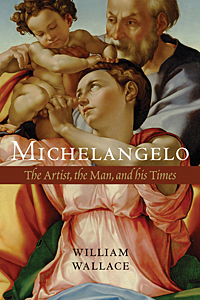While the story of Michelangelo’s artistic genius has been told many times, the story of his social ambitions has been told scarcely at all. Indeed, scholars have largely dismissed the artist’s claims to noble birth. Yet it was precisely that belief that propelled Michelangelo’s lifelong quest not only to improve his family’s financial position but to improve the very social standing of artists.
So argues Washington University in St. Louis art historian William Wallace in “Michelangelo: The Artist, the Man, and his Times,” a new biography published by Cambridge University Press.
Wallace, the Barbara Murphy Bryant Distinguished Professor of Art History & Archaeology in Arts & Sciences, is one of the world’s foremost authorities on Michelangelo. Working primarily from the artist’s own writings as well as those of his contemporaries, Wallace fashions a compelling and thoroughly modern portrait of both Michelangelo the artist and Michelangelo di Lodovico di Buonarroto Simoni, the aristocratic entrepreneur and businessman.
“Michelangelo is the best-documented artist of the early modern era,” Wallace said. “Nearly 1,400 letters by and to him survive, along with 300 pages of his personal and professional records, and an extensive correspondence among members of his immediate family. Then there are related documents: contracts, business and bank records, a nearly complete picture of the artist’s finances and property holdings, and the innumerable notices by his contemporaries.”
Despite the wealth of scholarly material, popular conceptions of Michelangelo have been shaped largely by three sources. The first two are Giorgio Vasari’s hagiographic “Lives of the Most Excellent Architects, Painters and Sculptors” (1550) and Ascanio Condivi’s somewhat more tempered “Life of Michelangelo” (1553), which was written at the behest of the artist.
“Vasari introduced his narrative by having God the father send Michelangelo into the world to save art from its manifold errors,” Wallace said. “In contrast, Condivi emphasized Michelangelo’s family and lineage as well as their illustrious descent from the medieval Counts of Canossa.”
Yet perhaps most influential to modern readers was Irving Stone’s fictionalized biography “The Agony and the Ecstasy” (1961), along with the film of the same title.

“Stone’s is the classic portrait of the irascible and misunderstood genius,” Wallace says. “Despite dozens of enduring friendships, his acquaintance with hundreds of persons, we persist in imagining Michelangelo as did Stone: an isolated, tortured genius, with few friends, an unappreciative family and impossibly demanding patrons.”
The Michelangelo who emerges in Wallace’s telling is a far more worldly figure. Apprenticed as a youth to the great Florentine painter Domenico Ghirlandaio, he is educated in the household of Lorenzo de’ Medici alongside princes and future popes. Later, as an architect and engineer, he oversees large-scale construction projects — including St. Peter’s Basilica in Rome and the Laurentian Library in Florence — involving hundreds of stonemasons, craftsman and other workers.
Meanwhile, though scholars have concluded that Michelangelo was not, in fact, related to the Counts of Canossa — a family that included the Countess of Matilda (1046-1115), who figures prominently in Dante’s Divine Comedy — such heady legends nevertheless were central to the artist’s self-conception.
“It is scarcely important that we now doubt Michelangelo’s blood relation, since it was firmly believed by the artist and his contemporaries,” Wallace said. “Many Italians claimed descent from the ancient Romans; others, like the Este family of Ferrara, traced their lineage to the Trojans, and the newly rich Medici claimed descent from one of Charlemagne’s captains.
“What is remarkable is that few artists before Michelangelo made such claims, and fewer still could believe them with any confidence,” Wallace said. “Not only did artists not have coats of arms, many did not even have proper last names. Artists were named after their fathers, after a profession, or after their place of origin, such as Michelangelo’s famous contemporaries, Leonardo da Vinci and Giorgione da Castelfranco.
“Possession of a surname was itself a sign of status, and Michelangelo was extremely proud of his.”
This pride would serve Michelangelo well during his famously tempestuous dealings with the equally strong-willed “warrior pope” Julius II. A great patron of the arts, Julius commissioned (some might say ordered) the artist to create both the Sistine Chapel ceiling and the pope’s own grandly scaled, if ultimately unfinished, tomb. Yet during a dispute over the latter project, Michelangelo defied the pope’s wishes and left Rome for Florence. He then spelled out — in writing — the conditions under which he would continue the work, instructing his holiness to “place the sum agreed at my disposal here in Florence.”
“It is one of the first times in history that the artist dictated the terms of work and wrote the contract,” Wallace said. “And to an imperious pope, no less.”
Conversely, in his largely respectful treatment of the artist, Julius II, “was implicitly recognizing the changed conditions of artistic patronage, at least in dealings with the likes of Michelangelo,” Wallace said. That acknowledgment “fundamentally altered the traditional relationship between artist and patron.
“This was ‘no painter outside his art,’ but a man to be treated with dignity and some delicacy.”
William Wallace
William Wallace has published extensively on Renaissance art. In addition to more than 80 articles and essays, he is author and editor of six books on Michelangelo, including the award-winning “Michelangelo: The Complete Sculpture, Painting and Architecture” (1998) and “Michelangelo at San Lorenzo: The Genius as Entrepreneur” (1994). In 1990, Wallace was among a select group of scholars, curators and conservators from around the world invited to confer with the Vatican about the restoration of Michelangelo’s frescos in the Sistine Chapel.